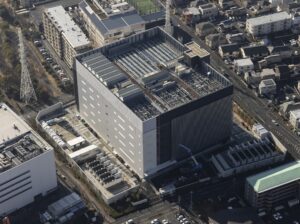In collaboration with Keysight Technologies
By Nancy Friedrich

Software-defined satellites have emerged as one of the hottest developments in a space industry producing countless technology innovations.
By integrating processing in the space platform, regenerative or software-defined satellites can demodulate, perform channelisation, and complete signal processing and modulation before retransmission.
This approach increases processing gain, ultimately reducing the full link budget. Another major benefit is that the satellite becomes a node in a network, which can assist in forming a highly intelligent network. With such enhanced flexibility and performance, software-defined satellites will be able to boost critical communications and enhance situational intelligence.
At the heart of the satellite communications payload is the digital processor. It converts the uplink frequency to digital to perform processing and then converts the signal back, at a different frequency.
From there, the signal is upconverted back to yet another different frequency for the “bent pipe” back to the ground. Historically, these digital processes were one-off.
Once the satellite designers built the satellite and loaded the software, they did not touch it again. Now, these satellite systems are reprogrammable, so the software can be uploaded to change the way RF signals are handled.
With software-defined satellites, operators can re-allocate or reconfigure a satellite for different tasks, regions, users, and more. If a satellite operator wants to change from covering one type of application with one bandwidth and beam pattern, for example, they can simply reprogramme the satellite.
To support more end users on demand, the satellites also can be programmed to handle increased bandwidth. Previously, operators could not alter a satellite’s function, so a new mission demanded a whole new satellite or development programme.
Software-defined satellites leverage advances in software-defined radio (SDR) techniques. For example, they demand sophisticated processor technology on board the satellite, taking advantage of graphics processing units (GPUs) and field-programmable gate arrays (FPGAs). The SDR techniques must be applied to the whole payload, which requires this additional processing power.
What’s next for software-defined satellites?
Given the obvious benefits of being able to re-assign or re-purpose a satellite, the concept of software-defined satellite or flexible payloads are gaining in popularity.
According to a market report from Advance Market Analytics, the key market drivers through 2030 will be scientific research as well as communications. For electronics and communication technology, software-defined satellites will enable the increased capabilities currently in demand from military and government through commercial organisations. Yet they also are expected to help satisfy the rising demand for autonomous satellites for deep space missions.
Deployments are expected in the next five years. Eutelsat will take delivery and possibly launch the Flexsat high-throughput, software-defined satellite in 2026. Built by Thales Alenia Space, the Flexsat is based on that firm’s ‘Space Inspire’ (INstant SPace In-orbit REconfiguration) product line enabling seamless reconfiguration and instant in-orbit adjustment.
The new satellite is expected to expand Eutelsat’s in-orbit assets with over 100Gbps of incremental capacity over the Americas. Eutelsat expects the optimised coverage, bandwidth allocation, and power levels to be leveraged across backhauling, enterprise, government, aerospace, and maritime solutions.
Helsinki-based startup ReOrbit plans to demonstrate its “software-enabled” satellite for Earth observation in the second quarter of 2025. With a connected platform approach, the company plans for the satellites to communicate with each other to streamline the delivery of space-related data.
ReOrbit’s Muon flight software stack, which acts like a satellite operating system, can be added into any existing satellite body. Its other product, Gluon, is a satellite platform equipped with optical communications terminals (OCTs) for space-space and space-ground links. This project is part of the European Space Agency’s UKKO programme for Earth observation satellites.
These examples show how software-defined satellites are being eyed for commercial and environmental/scientific use cases as well as military and government. For modern military scenarios, SATCOM advances can help to ensure spectrum and intelligence superiority. Software-defined satellites provide increased performance on demand, helping forces prevail in multi-domain operations.
The success of the promised improvements from software-defined satellites depend on them delivering on their performance claims. When the traditional satellite acted as a bent-pipe transceiver or a simple relay station receiving a signal, it only performed frequency conversion and amplification on the signal before retransmission.
Any propagation effect and noise added from the system ultimately degraded the signal and made completing the full link challenging. But testing bent-pipe transceivers is relatively simple compared to the more complex processing and digitalisation in the software-defined platform.
Nancy Friedrich is marketing manager of RF aerospace defence products at Keysight Technologies, specialising in areas ranging from space/satellite to EMSO, 5G, and MilCom. Previously, she led the marketing of aerospace defense industry solutions. In her former life, Nancy was executive director of a family of media brands including Electronic Design, Microwaves & RF, Power Electronics, and Machine Design.




